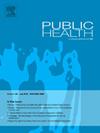Associations of changes in the dynapenia and cognitive function in middle-aged and older adults
IF 3.2
3区 医学
Q1 PUBLIC, ENVIRONMENTAL & OCCUPATIONAL HEALTH
引用次数: 0
Abstract
Objectives
Dynapenia is the age-related loss of muscle strength. Decreased muscle strength, including handgrip strength, is associated with cognitive impairment in older adults, possibly due to weakening of the neuromuscular system. However, changes in muscle strength and cognitive function may occur simultaneously and reflect aging. We aimed to investigate the relationship between repeated measures of muscle strength and changes in cognitive function and new-onset mild cognitive impairment (MCI) in middle-aged and older adults.
Study design
A prospective cohort study.
Methods
This study used data from the Korean Longitudinal Study of Aging, which was conducted from 2006 to 2020. The participants included 10,516 adults aged ≥45 years. Muscle strength was measured using handgrip strength and was divided into quartiles according to sex. Dynapenia was defined as handgrip strength <28 kg in men and <18 kg in women. MCI was defined as a Korean Mini-Mental State Examination score <24.
Results
In our repeated-measures longitudinal analysis, the odds ratios (OR) for MCI were 1.84 (95 % confidence intervals [CI]: 1.71–1.97) for dynapenia; 2.07 (95 % CI: 1.85–2.31), the lowest absolute handgrip strength; and 2.17 (95 % CI: 1.95–2.42), the lowest relative handgrip strength. After a 14-year follow-up, the hazard ratio for MCI was 1.29 (95 % CI: 1.15–1.46) in the newly diagnosed dynapenia group and 1.29 (95 % CI: 1.14–1.47) in the persistent dynapenia group.
Conclusions
Dynapenia and low muscle strength were associated with an increased risk of MCI over time. Furthermore, persistent and newly diagnosed dynapenia were associated with an increased risk of new-onset MCI in middle-aged and older Korean adults.
中老年人运动障碍与认知功能变化的关系
目的肌动力减退是一种与年龄相关的肌肉力量丧失。肌肉力量的下降,包括握力,与老年人的认知障碍有关,可能是由于神经肌肉系统的减弱。然而,肌肉力量和认知功能的变化可能同时发生,并反映衰老。我们的目的是研究反复测量肌肉力量与中老年人认知功能变化和新发轻度认知障碍(MCI)之间的关系。研究设计前瞻性队列研究。方法本研究使用了韩国老龄化纵向研究的数据,该研究于2006年至2020年进行。参与者包括10516名年龄≥45岁的成年人。肌肉力量用握力测量,并根据性别分为四分位数。握力不足被定义为男性握力28公斤,女性握力18公斤。MCI被定义为韩国最低精神状态考试分数24分。结果在我们的重复测量纵向分析中,运动障碍的MCI优势比(OR)为1.84(95%可信区间[CI]: 1.71 ~ 1.97);2.07 (95% CI: 1.85-2.31),最低绝对握力;2.17 (95% CI: 1.95-2.42),相对握力最低。经过14年的随访,新诊断的运动障碍组的MCI风险比为1.29 (95% CI: 1.15-1.46),持续性运动障碍组的MCI风险比为1.29 (95% CI: 1.14-1.47)。随着时间的推移,动力不足和低肌力与轻度认知损伤的风险增加有关。此外,在韩国中老年成年人中,持续性和新诊断的动力不足与新发MCI的风险增加有关。
本文章由计算机程序翻译,如有差异,请以英文原文为准。
求助全文
约1分钟内获得全文
求助全文
来源期刊

Public Health
医学-公共卫生、环境卫生与职业卫生
CiteScore
7.60
自引率
0.00%
发文量
280
审稿时长
37 days
期刊介绍:
Public Health is an international, multidisciplinary peer-reviewed journal. It publishes original papers, reviews and short reports on all aspects of the science, philosophy, and practice of public health.
 求助内容:
求助内容: 应助结果提醒方式:
应助结果提醒方式:


